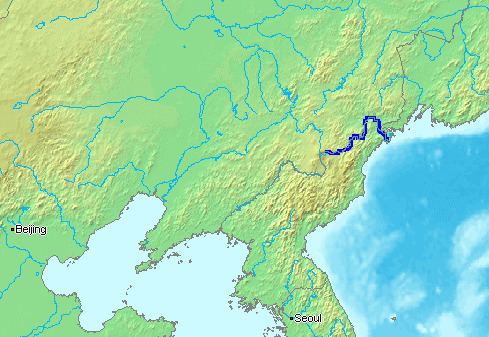- elevation 0 m (0 ft) Basin area 33,800 km² | Length 521 km Basin area 41,200 km² Bridges Tumen Border Bridge | |
 | ||
Countries North Korea, China, Russia | ||
A view of north korea from across the tumen river 28 january 2012
The Tumen River, also called the Tuman River ([tumanɡaŋ]; called the Duman in South Korea), is a 521-kilometre (324 mi) long river that serves as part of the boundary between China, North Korea and Russia, rising on the slopes of Mount Paektu and flowing into the East sea. The river has a drainage basin of 33,800 km2 (13,050 sq mi).
Contents
- A view of north korea from across the tumen river 28 january 2012
- Map of Tumen River
- Noktundo
- Illegal crossings
- References
Map of Tumen River
The river flows in northeast Asia, on the border between China and North Korea in its upper reaches, and between North Korea and Russia in its last 17 kilometers (11 mi) before entering the East sea. The river forms much of the southern border of Jilin Province in Northeast China and the northern borders of North Korea's North Hamgyong and Ryanggang provinces. Baekdu Mountain on the Chinese-North Korean border is the source of the river, as well as of the Amnok River (which forms the western portion of the border of North Korea and China).
The name of the river comes from the Mongolian word tümen, meaning "ten thousand" or a myriad. This river is badly polluted by the nearby factories of North Korea and China; however, it still remains a major tourist attraction in the area. In Tumen, Jilin, China, a riverfront promenade has restaurants where patrons can gaze across the river into North Korea. The Russian name of the river is Tumannaya, literally meaning foggy.
In 1938 the Japanese built the Tumen River Bridge, where the Quan River meets the Tumen River, between the villages of Wonjong (Hunchun) and Quanhe. Important cities and towns on the river are Hoeryong and Onsong in North Korea, Tumen and Nanping (Nanpingzhen, 南坪镇, in Helong County-level city) in China.
In 1995, the People's Republic of China, Mongolia, Russia and South Korea signed three agreements to create the Tumen River Economic Development Area.
Noktundo
Noktundo, a former island (now effectively a peninsula) at the mouth of the Tumen, has been a boundary contention between Russia and North Korea. The Qing Dynasty ceded the island to Russia as part of the Primorsky Maritimes (East Tartary) in the 1860 Treaty of Peking. In 1990, the former Soviet Union and North Korea signed a border treaty which made the border run through the center of the river, leaving territory of the former island on Russian side. South Korea refuses to acknowledge the treaty and demanded that Russia returns the territory to Korea.
Illegal crossings
The Tumen has been used for years by North Korean refugees defecting across the Chinese border. Most refugees from North Korea during the 1990s famine crossed over the Tumen River, and most recent refugees have also used it, as it is far easier than crossing the Yalu.
The river is considered the preferred way to cross into China because, unlike the swift, deep and broad Yalu River which runs along most of the border between the two countries, the Tumen is shallow and narrow. In some areas it can be crossed on foot, or by short swims. It also freezes in winter allowing dry crossings.
Defectors who wish to cross the Tumen often ignore its pollutants and dangerous border patrol, and spend weeks if not months or years waiting for the perfect opportunity to cross. "Long, desolate stretches of the Chinese-North Korean border are not patrolled at all", according to a New York Times article.
Refugees rarely cross the Tumen into Russia. This is because Russia's short stretch of the river is far better patrolled than China's stretch. In addition, there is no sizable ethnic Korean community in Russia to receive support from, as opposed to China, which has a larger Korean population.
The Tumen is also crossed illegally by soldiers and others seeking food and money. Some Chinese villagers have left the border area because of the attacks.
The humanitarian crisis along the Tumen River was dramatized in the 2010 dramatic feature-length film, Dooman River.
